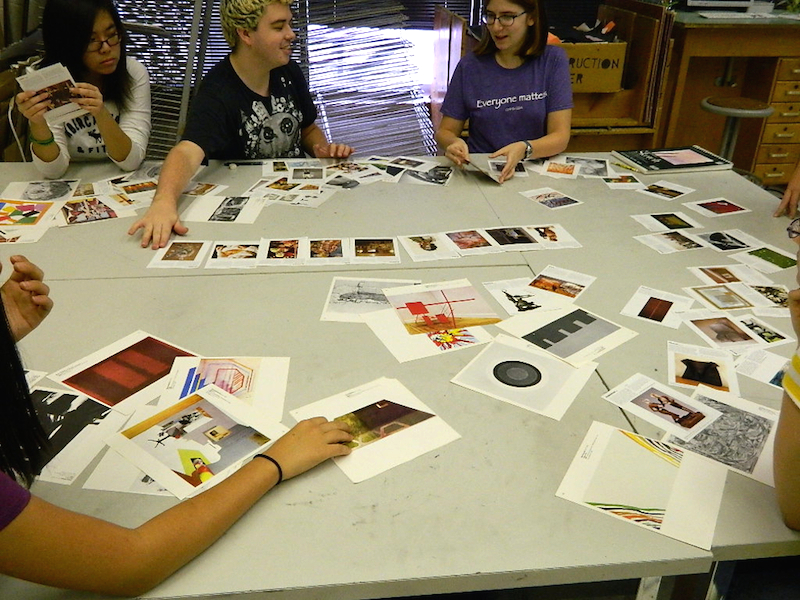
Students in Jack Watson’s Visual Art III class place contemporary prints in sequence to create a thematic, nonverbal conversation between artworks. After wordlessly relating the formal principles and functions of these works, students spoke about works that appealed to them, following their own curiosity. Some students asked to keep the prints to hang in their art lockers.
In art classrooms, the word value means different things to different people. To the teacher, it describes the lightness or darkness of a color, but to the students, it often means how much an artwork is worth. Rarely is there any discussion about the other kind of values, the set of beliefs or standards that guides evaluations of artworks. However, students make value judgments all the time without even realizing it; it’s a knee-jerk response to looking at artwork. The formal method of critical analysis asks students to reserve judgment until the end of the process (after description, formal analysis, and interpretation) although some educators have criticized this method because it is natural to judge art throughout one’s experience with it. A good system of interpretation acknowledges this but also involves some reflection about what the viewers contribute to their interactions with artworks.
Evaluation thus becomes a balancing act, one that allows a natural reaction to what grabs us, but mediates the impulse to assign a value, like good or bad, to that reaction. This is especially relevant in the case of contemporary art, in which the initial impression of the work may not yield a positive response. I am thinking in particular of conceptual and socially engaged artworks like Félix González-Torres’s Untitled (Portrait of Ross in L.A.), which sometimes elicits a negative reaction from students (“That’s not art because I could do that”) or a comical one (“I wish I had all that candy!”). But once a viewer takes a piece of candy from Gonzalez-Torres’s pile—interacting with the artwork and, in a sense, collaborating with the artist—and reads the wall label—which conveys the artist’s intent, the loss of a loved one to AIDS—the artwork acquires a gravity and intimacy that supplants superficial value judgments.
Félix González-Torres. “Untitled” (Portrait of Ross in L.A.), 1991. Candies individually wrapped in multicolored cellophane, endless supply; overall dimensions vary with installation, ideal weight: 175 lb. The Art Institute of Chicago; promised gift of Donna and Howard Stone. Courtesy of Andrea Rosen Gallery, New York © The Félix González-Torres Foundation
This process, of course, takes time. It takes time and patience and openness to interact with an artwork that does not offer a tidy, immediate resolution. It takes time to discover layers of meaning and time to slow down and get to know a work of art, just as one would get to know a person. But it also takes self-awareness on the part of the viewer. Viewers who are reflective about their personal systems of values are rewarded by their interaction with contemporary art, be it positive or negative. For this reason, I believe there is value (yes, another kind) especially for students in delaying judgment until after one performs the due diligence of formal analysis and interpretation. If nothing else, it affords a viewer the time to experience and comprehend the work. But it also requires the viewer to be actively looking and deeply thinking. If at the end of this process a viewer decides, continuing with the earlier example, that González-Torres’s work is still nothing but a pile of cheap candy, one that any kid could make, it reveals as much about the viewer’s values as it does the merits of the work.